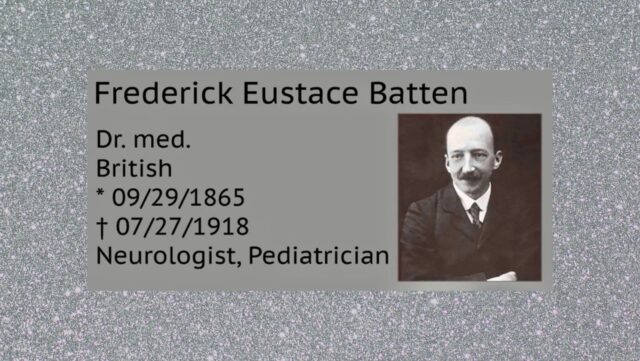
Knowledge is power. Indeed, it is. Perhaps you just heard of Batten Disease for the first time in “The Saint of Second Chances.” That’s okay. What matters is you are here now and interested in learning about Batten Disease.
There is much for scientists to discover about this rare but fatal disease. Hence, our goal here is to simply break down the complex medical information we do have. Hopefully, it will allow you to gain a better understanding of why help is needed.

The Batten Disease name rightfully salutes British physician Frederick Batten. His courage, dedication, and leadership are responsible for recognizing and describing the characteristics and rare pattern. It was amazing work made even more impressive when you consider it took place back in 1903.
Dr. Batten is often called “The Father of Pediatric Neurology.” His work and passion laid the foundation for any future success with treatment or a cure for the disease named after him.
What is Batten Disease?
Batten Disease is the term used for a class of diseases attacking the central nervous system in children. 13 types of the disease have been identified.
Basically, we are talking about a group of fatal genetic disorders. The specific term is neuronal ceroid lipofuscinoses. You will often see them being called NCLs. Clinical researchers know what happens with them. Unfortunately, the agonizing unknowns are the reasons why.

Let’s look at what causes Batten Disease. Mysteriously, brain cells become unable to recycle certain molecules. Therefore, they begin to lose their ability to perform important tasks. This increasingly creates failure because the cells cannot break down and dispose of waste such as proteins, sugars, and fats.
The buildup of waste in a cell can result in changing the structure of a gene. This is a mistake known as a mutation. Because these problem mutations can develop in different genes, it explains why there are 13 known forms of Batten Disease.
In any case, when the buildup of a cell’s waste gets bad enough, signs of the disease appear.
Batten Disease Symptoms
First and foremost, prepare yourself emotionally for the symptoms. If this diagnosis is invading your inner circle, the reality is likely devastating. The patient will be afflicted in ways seemingly unfair, merciless, or downright cruel. There is no other way of stating it honestly.
From the human perspective, Batten Disease is where Heartache Meets Heartbreak.
Like other fatal conditions, the patient’s gradual progression of the disease means deteriorating quality of life. This is also true for loved ones helplessly forced to watch it unfold. The most common early symptoms are seizures and loss of vision. Other abnormal movements such as tics, twitches, and muscle spasms can also occur.
You will see the patient’s everyday learned skills diminishing. This may include eating, walking, and maintaining balance. Talking challenges are also common. These range from frequently repeating phrases, delays in speaking, and stuttering.
Once the disease progresses, the patient’s symptoms worsen.
This phase may include significant behavior and personality changes. You may find the patient hallucinating and losing touch with reality. The result can feel like losing the person you knew and/or who knew you.
Often making things progressively worse can be the onset of dementia. In addition, Batten Disease may result in:
- Anxiety
- Clumsiness to the point of serious risk of injury
- Confusion
- Further loss of vision
- Tremendous difficulty sleeping
As conditions worsen, the frequency and severity of seizures will often increase. Communication skills usually deteriorate. Cardiac problems can surface. Weakness in the limbs may lead to limited ability to walk or move. Even total paralysis is possible.

The final chapter of Batten Disease can be described as a total nightmare. Mercilessly, you can expect the patient to become bedridden, or wheelchair bound. Most cognitive function will be gone. The deadly trio of blindness, dementia, and Parkinson’s-like symptoms is as unimaginable as it is brutal.
All Symptom Timelines Occur Too Soon
Most times these rare forms of NCLs begin to emerge during childhood. Here in order are the 3 options:
1: This one is uncommon. Those with the various infantile forms of the disease are usually showing symptoms before their 1st birthday. It means very early on, the worst fears of every parent are coming true. One cannot help but noticing something is seriously wrong with this beautiful, little bundle of joy.
2: The most common scenario. The onset of the disease occurs between 5 and 10 years old. In these cases, it appears to all that a normal healthy baby has been growing and developing into a normal healthy child.
3: Another uncommon option. In such cases, an even more delayed onset is not becoming visible until the early teenage years. Onsets a few years later such as early adulthood are the rarest of the rare.
Is there a Cure for Batten Disease?

It hurts yet helps to be brutally honest here. NO. Currently, there is no cure for Batten Disease. It remains one of the great enigmas in clinical research.
The disease being mysteriously and unknowingly passed down by both parents makes the experience even more shocking and soul-crushing.
The rarity of 3 known cases for every 100,000 births in the U.S. means a challenge in prioritizing funding for research. Those of Scandinavian and Northern European descent have a slightly higher risk.
Still, in being truthful, there is reason for believing in a promising future.
Exciting progress is visible with CLN2.
High-quality research institutions are leading the way. Institutions such as The University of Iowa Institute For Vision Research, along with the University of Rochester, Rutgers University, and others are dedicated in their pursuits for knowledge and cures.
The most exciting progress is seen through the form of Batten Disease known as CLN2. This generally surfaces in children with the disease between the ages of 2 and 4. Researchers got their first break in discovery by identifying the genetic defect. It was a missing protein in the cell. Next, came developing a treatment for producing that protein in the cell.
Finally, ironclad proof of progress now exists. There is now an FDA approved treatment for fighting this one class of disease.
Meantime, The University of Iowa Institute For Vision Research excitedly has the ability to produce human retina in a dish. Their methodology is to take cells from a patient and convert them into stem cells. Once this happens, they transform the stem cells into photo receptor cells and give them back to the patient.
This is more than tremendous progress for curing blindness. When you realize the retina is an outreach of the brain consisting of brain tissue, you can see how clinical research can offer multiple benefits for gaining on Batten Disease.
Holding on to Hope
You might be thinking we should gently end here on a high note. We easily could. Nonetheless, there is also added value in a silver lining with a personal touch.
What is Batten Disease? It is a burning question for those who know about it. However, keep mind hope and progress for you can be different than someone else. This is especially true if loved ones are desperately seeking a cure.
Regardless, holding on to hope is a good thing. You have just read and seen why. Hope for treating and curing forms of Batten Disease is more than good or wishful thinking. It is legitimately worthy. Sadly, Batten Disease is real. But on the bright side, so is hope for a cure.




